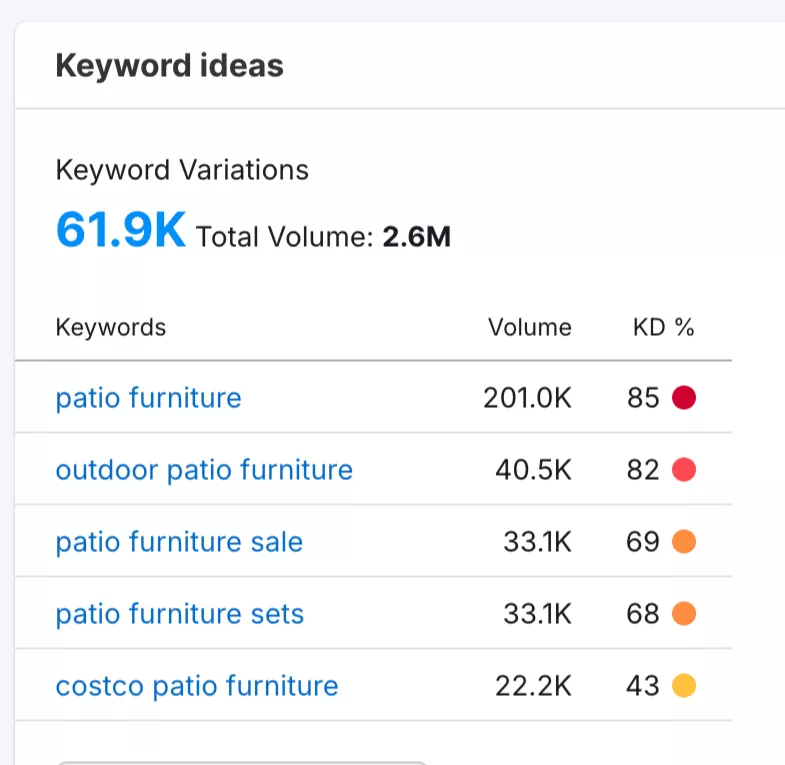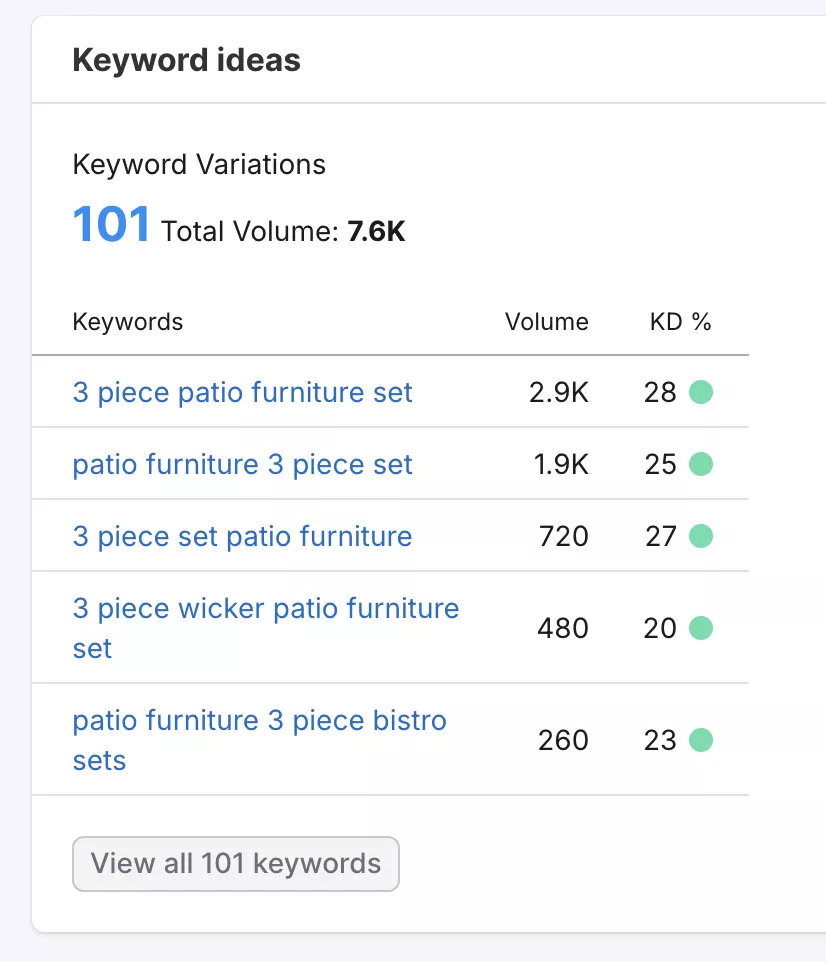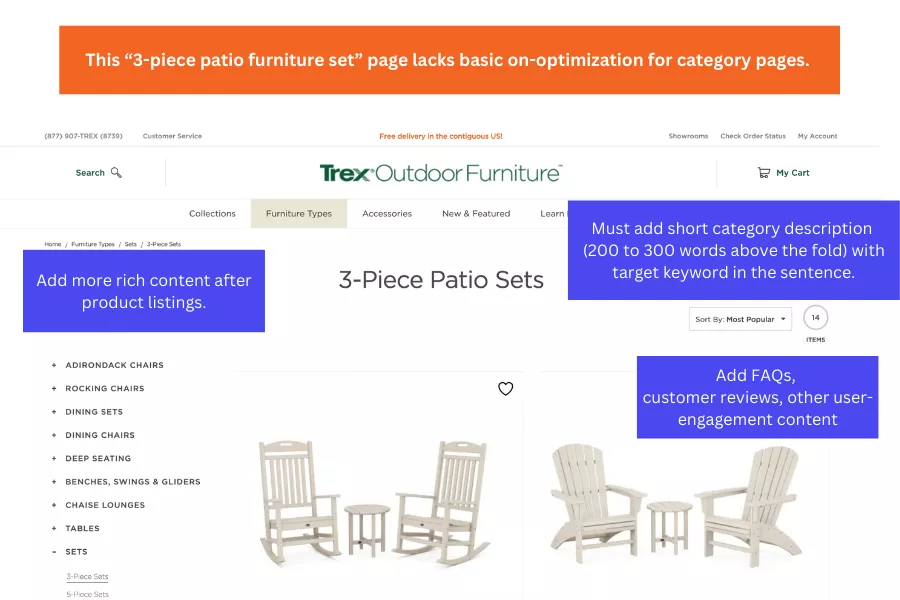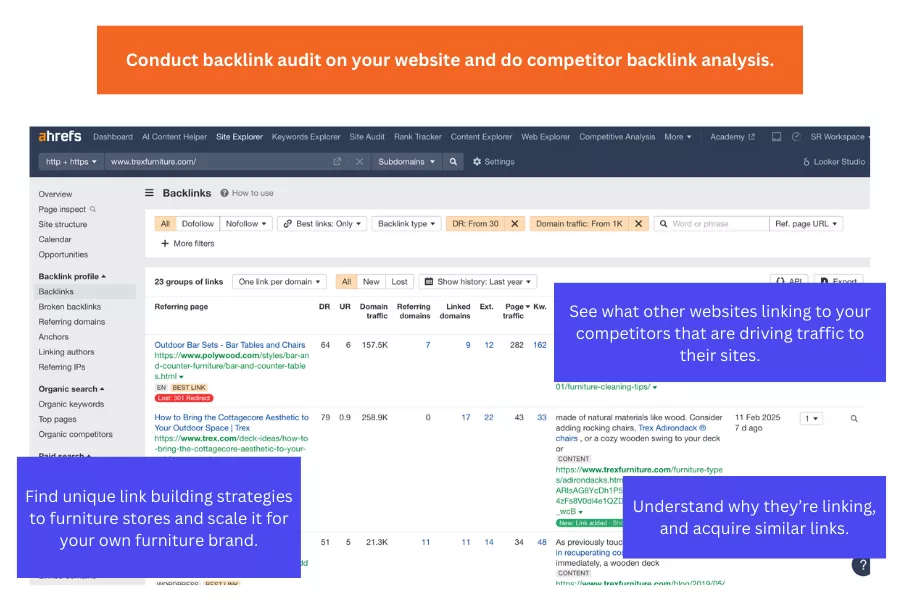by Venchito Tampon Jr | Last Updated on February 19, 2025
Furniture SEO is dominated by large retailers like Amazon, Wayfair, and IKEA, which have strong brand equity, massive backlink profiles, and deep pockets for marketing.
On top of that, the furniture industry presents a unique challenge with buyers requiring research, comparison, and high customer trust—as price tags are in mid- to high-level purchases—which demands search engine optimization and optimizing the online store for optimal conversions.
What is Furniture SEO?
Furniture SEO is the process of optimizing a furniture store to increase its online search visibility. It involves technical SEO, category page and product page optimization, product listings, content marketing, link acquisition, and local SEO for physical stores—all of which help the store rank for target furniture commercial keywords.
SEO Strategies For Furniture Stores
If you seriously want to get a piece of the search pie for furniture commercial keywords in Google’s SERPs, this guide will walk you through the step-by-step process of how we help furniture stores like yours make it.
Rank Faster With This Keyword Research Strategy
Unlike traditional SEO campaigns, eCommerce SEO for furniture stores involves ranking for furniture commercial keywords with category or collection pages.
The more long-tail keywords you can target and optimize for existing and new category or collection pages, the more search traffic you can acquire for your furniture store.
Avoid Broad, Highly Competitive Keywords
Unless you have strong brand equity and high domain authority (>DR50), pushing hard to rank for broad, highly competitive keywords will take you more than a year.
Take a look at the head term “patio furniture”, which has 201K monthly searches (estimated) and 85% keyword difficulty (KD)—as of this writing.

The top-ranking page is Home Depot, which has strong authority and trust signals and a DR90—the page alone has 385+ unique referring domains linking to it. The cost of building it, assuming it costs $250 per link, would be somewhere around $70 to $90K, not including all the brand, trust, and authority signals the top-ranking websites have built over the decade. In short, it’s not easy to rank for the head term.
That is not to say you can’t outhustle these furniture giant retailers; there’s a smart move to rank faster for furniture stores with strategic keyword research.
For this keyword research process, you can use either Ahrefs or SEMRush. While there are many free keyword research tools—in my experience, they only present a handful of niche keywords to target (with irrelevant metrics, to be honest).
Use High-Intent Keyword Variants
Instead of targeting “patio furniture”, consider long-tail keywords that are easier to rank with category pages. Examples of these furniture variant keywords are the following:
- “3-piece patio furniture set”
- “4-piece patio furniture set”
- “wicker patio furniture set with fire pit”
- “outdoor wicker patio set”

As of this writing, the keyword “3-piece patio furniture set” may have a lower search volume (2,900 monthly searches) but a significantly lower keyword difficulty of 28KD. It’s one of those goldmine keywords where you can rank easily by applying foundational optimization to your category page.
You can go deeper with your keyword research process by analyzing the top-ranking web pages.
In your analysis, remove big brands like Wayfair or Home Depot, as it won’t be easy to outhustle them. Instead, see if there are any ranking-growing websites you can’t outrank with the right eCommerce SEO strategy.
Do Competitor Analysis For More Long Tail Commercial Keywords
Expand your list of long-tail commercial keywords by entering competitors’ webpages in Ahrefs or SEMRush to see what other product keyword variants they also rank for.
Do it for every other keyword you want to target.
The key is to create a long list of long-tail buyer keywords for which you can optimize your current and many new category or collection pages.
Optimizing Furniture Category or Collection Pages
One of the common mistakes in doing SEO for furniture stores is investing most of their resources trying to rank individual product pages.
Given that users want to browse multiple options rather than land on a single product page, Google has changed its search intent for the majority of commercial keywords for online stores—it now favors collections and category pages.

Essential On-Page Optimization for Furniture Category Pages
Category optimization is one of the main priorities of our eCommerce SEO campaigns—do it with finesse, and you’ll see quick results in weeks.
Generally, a well-optimized category page must balance SEO with user experience. It should both serve its target users and have the fundamental SEOs set up to send rich signals to Google about its relevance to the keyword it is targeting.
Start with SEO basics, such as optimizing the H1 title to match the primary keyword. For instance, if you’re targeting “3-piece patio furniture”, your H1 could be “3-Piece Patio Furniture Sets – – Stylish & Weather-Resistant Outdoor Seating”.
One of the biggest mistakes eCommerce retailers make is treating their category page like a product listing page—thin content does not make it worthy of ranking for its target keyword.
The solution to this is to add a short category description above the fold (200 to 300 words), which includes:
- Putting the target keyword in the first sentence.
- Adding unique selling points (e.g., “Handcrafted wooden coffee tables made from sustainable materials”).
- Briefly mention product variety (e.g., “Choose from solid oak, reclaimed wood, and walnut finishes.”).
- Another SEO best practice is including an extended description below the product grid (600 to 800 words).
- Use H2s and H3s to further optimize the furniture category page.
Break down information and provide more helpful content to the furniture buyer. You can cover details such as:
- Materials & Construction (e.g., Aluminum vs. Wicker)
- Size & Space Considerations (e.g., Best for Small Patios or Spacious Backyards)
- Styling Tips & Trends (e.g., How to Style a Modern Outdoor Lounge)
Lengthier, more informative, and highly engaging content that answers buyers’ questions without sacrificing user experience helps improve the website rankings of your furniture store’s category pages.
Optimize Category Page URLs for Crawlability
How the slugs of your site’s category page URLs look matters in SEO. They need to be real words instead of alphanumeric strings as much as possible.
- ✅ yourstore.com/sofas/modern-sofas (Good)
- ❌ yourstore.com/category?id=123&filter=modern (Bad)
Keep these category pages’ URL structure short, clean, and keyword-rich. Structuring it this way helps bots and humans with ideas on what the pages are all about, which helps in better crawlability and user experience.
Smart Internal Linking Strategy For Category Pages
Conduct an internal linking audit on your website, as this strategy alone can profoundly impact your ability to rank for your target furniture keywords. One observation I’ve seen is that most online furniture stores focus more on inbound link acquisition without doing much work upfront with internal linking campaigns.
Your internal links help you spread link equity across your web pages, including orphan pages (with no internal links pointing to them), making them difficult for search engines to discover and index.
You can use Ahrefs to crawl your website easily and identify pages without internal links. Filter the results to show only category or collection pages to see if they appear as orphan pages.
If the category page does not have internal links from your homepage, other categories, or blog content, it is likely orphaned.
Go to related categories and add internal links to the web page’s content (e.g., “Dining Tables” → “Dining Chairs”).
Include links even from your blog posts (e.g., “How to Choose the Best Patio Furniture” → “Outdoor Furniture” category).
By fixing orphan pages and creating holistic, smart internal linking across related web pages of your furniture store, you improve your site’s crawl efficiency, making these category pages more discoverable by search engines.
Sorting by Customer Reviews to Improve Conversions
One underutilized but powerful category page optimization strategy is sorting products by customer reviews than relying on default sorting options like “Best Sellers” or “Newest Arrivals”.
To improve usability, allow shoppers to filter results by star ratings (e.g., “4 stars & up”). This will help users find well-reviewed products faster, improving engagement and reducing frustration.
Fix Pagination Issues for Better Indexing
Pagination issues are a common hurdle for most furniture eCommerce websites, especially for large product categories that contain multiple pages of listings (e.g., “Living Room Furniture—Page 1, Page 2, Page 3”).
Poorly optimized pagination can lead to indexing issues, ranking dilution, and crawl inefficiencies, making it difficult for Google to understand your website’s structure.
Fixing pagination issues helps you avoid duplicate content issues, which are often caused by identical meta tags or lacking unique content. Google may flag these as duplicate pages.
Of course, different furniture online stores have different technical SEO issues, but here are general how-tos:
- Use rel=”next” and rel=”prev” (if applicable) to signal paginated relationships.
- Ensure paginated pages are crawlable and indexed by search engines.
- Use self-referencing canonical tags on each paginated page (instead of pointing all pages to Page 1) to allow search engines to index them appropriately.
- Implement a “Load More” button instead of an infinite scroll for improved discoverability. If infinite scroll is necessary, ensure that Googlebot can access paginated versions through proper HTML links.
Build Topical Authority with Blog Content
Google favors brands that provide comprehensive, in-depth content on specific topics beyond their category pages, recognizing their industry thought leadership.
You build topical authority on how well your furniture store covers a subject in depth, making it a trusted source for search engines and users.
Implementing the Hub & Spoke Model for Furniture Content
A hub-and-spoke (content cluster) strategy helps organize content around main topics and ensures that Google sees your site as an authority. Instead of writing random blog posts, you should group content around key furniture categories.
Here’s what it looks like in actual practice:
Hub (Main Topic / Category Page)
Example: Modern Sofas
Spokes (Supporting Content / Blog Posts)
- Best Color Combinations for Modern Sofas
- Leather vs. Fabric Sofas: Pros and Cons
- How to Arrange a Sectional Sofa in a Small Space
- How to Clean & Maintain Your Modern Sofa
Each spoke (others refer to it as topic clusters) links back to the main category page (Modern Sofas). Spokes or topic clusters also link to each other, reinforcing topical relevance and passing link equity across related pages.
Aligned to the hub-and-spoke model (or topic clustering model), here are proven blog templates for furniture stores that you can publish and promote.
How-To Guides
Customers frequently search for advice on arranging, maintaining, and selecting furniture. It is one of the common topics with a significant search volume, so providing detailed, actionable guides positions your brand as an expert in home furnishings.
A few examples of this type of content are:
- How to Arrange Living Room Furniture for Small Spaces
- How to Protect Outdoor Furniture from Weather Damage
- The Best Way to Clean and Maintain a Leather Sofa
Comparison Articles
Many customers compare materials, designs, and price points before purchasing furniture. Publishing detailed comparison articles not only answers key buyer questions but also helps users make smart purchasing decisions.
Examples of comparison articles are:
- Wood vs. Metal Dining Tables: Which One Should You Choose?
- Leather vs. Fabric Sofas: Pros and Cons
- Memory Foam vs. Spring Mattresses: Which is Better for You?
Interior Design Trends
Trends, particularly those related to interior designs, build more EEAT signals on your furniture store, as only experts in the field can share or predict trends around many industry topics. Topics such as top home decor trends, minimalism, and the best color combinations for modern bedrooms are good examples in this category.
Buying Guides
Generally, for eCommerce SEO campaigns, you’ll find buying guides as a solid blog template, given its ability to educate customers with specifics to the products while naturally linking to relevant products within the body of the content. Some examples of these are:
- The Ultimate Guide to Buying a Recliner Chair
- Best Office Desks for Remote Workers: What to Look For
- How to Choose the Perfect Dining Set for Your Home
Authority Signals Through Link Building
eCommerce link building this year isn’t just about the number of links—it’s about acquiring more high-quality, relevant backlinks to reinforce strong authority and trust signals (off-page SEO) for your furniture store.
Generally, you want to build backlinks to your category or collection pages and your blog content, from which you would build internal links to other collection pages and product pages. You would only be wasting resources if you push links to your product pages, as they don’t deem to rank after all.

There are many scalable strategies, but the ones that truly fit the furniture space are the following:
Link Insertions
Instead of writing guest posts from scratch, you leverage existing web pages with high-traffic content (some already ranking) to acquire links. It’s easier to scale this tactic than other link-building strategies, as it all demands to prospect for relevant blog articles.
Start link insertions by finding relevant home decor and lifestyle articles with existing traffic.
Reach out to site owners, suggesting your blog post or collection page that compliments their content.
Alternatively, you may offer content enhancement (sharing updated stats, expert quotes, and new insights) for a link to your category page.
Digital PR
High-level guest posting to get contextual backlinks on top-tier publications still works, but it requires solid authorship to penetrate the editorial guidelines of those niche blogs.
The best alternative is launching your digital PR campaigns. By providing expert commentaries on topics of interest by journalists, you’re gaining traction, brand visibility, and backlinks straight to your homepage (“branded links”). Editors from Apartment Therapy, The Spruce, and Elle Decor are the best examples of top-tier publications that garner expert input from thought leaders—that could be you if you execute digital PR correctly.
Local SEO For Furniture Physical Stores
For furniture stores with brick-and-mortar locations, local SEO plays a big role in driving foot traffic, more local search visibility, and in-store conversions—for which online marketing strategies won’t suffice.
Google prioritizes brands that optimize for “near me” searches through Google Business Profile optimization ranking for Google Maps and organic local search results listings.
There are several local SEO guides to get practical tips, but here are the top priorities for this matter:
- Claim and verify your Google Business Profile and make sure your business information is consistent and accurate, including your Business Name, Address, and Phone Number (NAP).
- Upload high-quality images showcasing storefronts, furniture collections, and showroom setups. This will entice more actual visits from your potential local customers.
- Include secondary categories to highlight expertise or more specific product offerings (e.g., “mattress store” or “office furniture store”).
- Build local citations and legit directories with NAP consistency (Yelp, Houzz, Angi, BBB, Yellow Pages, and Local Chamber of Commerce).
- Incentivize or ask customers to leave Google reviews to improve local rankings and trust in your Google Business Profile. Engage by responding to every review.
For further readings, here are some of our extensive guides on doing local SEO:
SharpRocket—Agency of Choice For Furniture Stores
Book a strategy call with our CEO if you want to rank your category or collection pages for your furniture commercial keywords. We’ll then show you a furniture SEO roadmap to increase your search traffic and organic revenue.
Furniture SEO FAQs
How Do I Advertise My Furniture Work?
To effectively advertise your furniture business, start with a combination of SEO, social media marketing, and targeted advertising.
- SEO (Search Engine Optimization) – Optimize your website and product pages to rank for relevant furniture keywords, driving organic traffic and long-term organic visibility.
- Social Media Marketing – Use Instagram, Pinterest, Facebook, and TikTok to showcase your furniture, post customer testimonials, and engage with potential buyers.
- Google & Facebook Ads – Run paid advertising campaigns targeting high-intent buyers searching for furniture. Invest $100 to $200 a day.
- Influencer & Affiliate Marketing – Partner with home decor bloggers and YouTubers to feature your products in home design content.
Who is the Target Audience for a Furniture Business?
Your target audience depends on the type of furniture you sell. Common customer segments include:
- Homeowners & Renters – Searching for sofas, beds, and home decor.Interior
- Designers & Home Decor Enthusiasts – Looking for custom, luxury, or trendy furniture.
- Businesses & Offices – Interested in office desks, ergonomic chairs, and workspace furniture.
- Property Developers & Realtors – Needing staging furniture for homes, apartments, or showrooms.
💡 Pro Tip: Use Google Analytics to track your website’s current visits & Facebook Audience Insights for your Facebook and Instagram Pages to refine your customer demographics.
What Keywords Are Best for Furniture SEO?
The best furniture SEO keywords include a mix of broad, long-tail, and local search terms, and are likely depend on your ideal customer profile, and business location. But here are few examples to help you generate ideas on your own.
Category-Based Keywords:
- Modern Sofas for Living Room
- Luxury Dining Tables for 6
- Ergonomic Office Chairs for Back Support
Long-Tail Buyer Intent Keywords:
- Best Sectional Sofa for Small Spaces
- Affordable Wooden Coffee Tables Under $500
- Outdoor Wicker Furniture Set with Fire Pit
Local SEO Keywords:
- Furniture Store in Los Angeles
- Custom Wood Furniture Near Me
- Best Office Furniture Supplier in Chicago
💡 Pro Tip: Use Ahrefs, SEMrush, or Google Keyword Planner to find high-converting, low-competition keywords.
How to Generate Leads for a Furniture Business?
Here are actionable tips to generate leads for your furniture business:
- Use Lead Magnets – Offer free design guides, exclusive discounts, or style consultations in exchange for emails.
- Optimize Google My Business (GMB) – Rank for local searches like “Best Custom Furniture Store Near Me”.
- Partner with Home Improvement & Real Estate Businesses – Cross-promote your furniture with interior designers, real estate agents, and Airbnb hosts.
- Encourage User-Generated Content (UGC) – Ask customers to share photos & reviews for social proof.
- Host In-Store or Virtual Events – Conduct home styling workshops or live product demos on social media.
💡 Pro Tip: Retarget website visitors with Facebook and Instagram ads to convert warm leads into buyers.
The Author
Venchito Tampon Jr
Venchito Tampon is a Filipino Motivational Speaker, Corporate Trainer, and a Leadership Speaker in the Philippines. He is the CEO and Co-Founder of SharpRocket, a link building agency. With a decade of experience, Venchito has a proven track record of leading hundreds of successful SEO (link builidng) campaigns across competitive industries like finance, B2B, legal, and SaaS. His expert advice as a link building expert has been featured in renowned publications such as Semrush, Ahrefs, Huffington Post and Forbes. He is also an international SEO spoken and has delivered talks in SEO Zraz, Asia Pacific Affiliate Summit in Singapore, and Search Marketing Summit in Sydney, Australia. Check out his other businesses, Hills & Valleys Cafe, Blend N Sips and Saas Pursuit.
How our LINK BUILDING AGENCY builds 250 links/mo consistently using Predictable Link Building Methodology™…
- Using a SIMPLE and PROVEN system
- Using a SCALABLE strategy
- No private blog networks
- No creepy outreach emails
